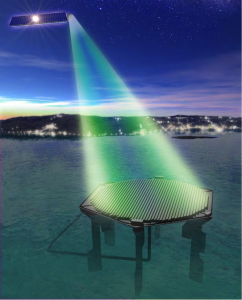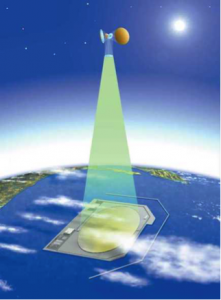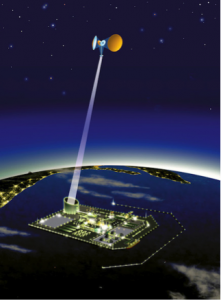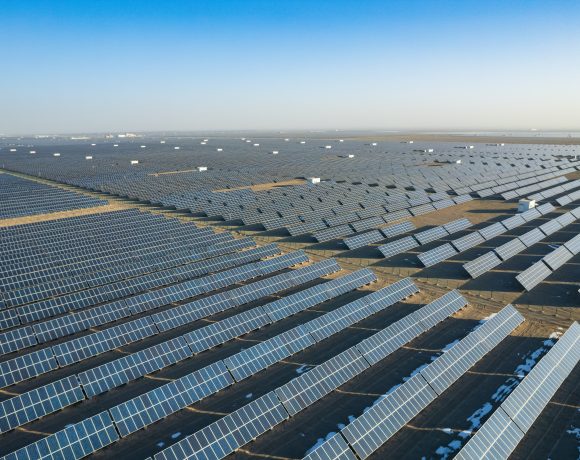- Konstantin Tsiolkovsky, commonly known to have presented the concept of transferring the solar power from space to Earth for the first time, believed the motivation for space exploration is the “pursuit of energy”, not the “conquest of planets”. No other renewable energy source is comparable—in terms of available power—to the Sun.
- Solar Power Satellite (SPS) is a huge satellite of a few km and of over 10,000 tons with solar cells and wireless power transfer unit in geosynchronous equatorial orbit. The generated electricity of over 1 GW in the solar cells—about the same output as a typical nuclear power plant.
- Japan has a particular interest in finding alternative clean energy sources, especially after the Fukushima Daiichi nuclear disaster in 2011, and taking into account the lack of surface for renewable power plants installations and in response to the demand for realising low-carbon society on the global scale.
“Men are weak now, and yet they transform the Earth’s surface. In millions of years their might will increase to the extent that they will change the surface of the Earth, its oceans, the atmosphere and themselves. They will control the climate and the solar system just as they control the Earth. They will travel beyond the limits of our planetary system; they will reach other Suns and use their fresh energy instead of the energy of their dying luminary”
– Konstantin Tsiolkovsky, 1857–1935

Image Credit and Calculations: Courtesy of Prof. Naoki Shinohara, Kyoto University
Conceptual view of a Solar Power Satellite (SPS) orbiting Earth at ca. 36,000 km altitude.
The generation of 1 GW power—typical capacity of a nuclear power plant-block—requires a surface of 2 km solar cells and a 2 km microwave antenna installed on the SPS on-orbit, and a 2–4 km receiving antenna installed on the Earth surface. The Energy Availability Factor of a space-based Photovoltaics (PV) is >90% compared to ground-based PV <15%.
Historical overview
In the course of his lifetime, Konstantin Tsiolkovsky, published over 160 works predominantly on the topic of technosphere, which he describes as “a set of industrial, transportation, energy, communication and household mediums that are designed in a way to ensure the most efficient use of all resources available to the mankind”. Tsiolkovsky believed the motivation for space exploration is the “pursuit of energy”, not the “conquest of planets”. No other renewable energy source is comparable—in terms of available power—to the Sun. The free energy of our Sun is not used by mankind, moreover the Earth by itself receives only 1/2000000000 portions of the radiant energy, according to Tsiolkovsky’s calculations. He analogised the Earth’s atmosphere and its clouds, fogs and dust powders to bandits on the passage of solar energy to us on Earth!
In an article published in 1923 entitled, “Solar energy and its applications. Solar radiation energy”, Tsiolkovsky described a system of mirrors in the open space collecting the solar energy and directing it to the Earth, providing a much stronger sunlight. A year later, he conceptualised a device that consisted of a system of mirrors for gathering light connected to a water tank for household needs. According to his evaluations, ten big coffee cups can be cooked in two minutes in cases where the absorption surface is 10 square meters. Nonetheless, he was admitting the risk of having “no water, no coffee, no dinner” on cloudy days!
It is commonly believed that Konstantin Tsiolkovsky presented for the first time the concept of transferring the solar power from space to Earth, thanks to his system of mirrors installed in the free-space. Nonetheless, in Tsiolkovsy’s method the sunlight was only redirected from the orbit to a specific point on the Earth’s surface. This science-fictional idea was later advanced in Isaac Asimov’s 1941 story, “Reason”, in which a space station transmits energy collected from the Sun to various planets using microwave beams. It was only in 1968 that the first engineering concept of a solar power satellite (SPS) was proposed by Peter Glaser (1923–2014), whereas the wireless power transmission (WPT) was much advanced in the 1960s by William C. Brown (1916–1999).
Why on Earth “Space-based Solar Power”!?
Generating solar energy is a conventional alternative technique of supplying household’s energy consumption nowadays, a rather cheap and effective method requiring a solar panel on the roof and a sunny sky! In spite of late advancements, a ground-based solar energy system has its intrinsic limitations; they can generate energy only during the daytime and most of sunlight is lost through the atmospheric passage of sun rays. Thereby, Tsiolkovsky’s concern of “having no coffee” on cloudy or rainy days was rather correct!
Let’s now imagine a solar satellite orbiting the Earth—in an always-sunny location collecting non-stop 24/7 solar energy of much higher intensity—and beaming it through microwave waves [or laser] all along the way to a ground-station, which is capable of converting the microwave power to electricity and injecting it into power grids. This is potentially a long-term sustainable method of supplying clean energy to Earth.


Solar Power Satellite (SPS) systems: (left) microwave type (right) Laser type [Credit: JAXA]
From Fiction to Reality – Technological Challenges
Solar Power Satellite (SPS) is a huge satellite of a few km and of over 10,000 tons with solar cells and wireless power transfer unit in geosynchronous equatorial orbit. The generated electricity of over 1 GW in the solar cells—about the same output as a typical nuclear power plant—will be wirelessly transmitted to ground via microwaves or laser. Key technologies for the SPS are
(1) a launch system to launch several tons of materials to the orbit;
(2) construction and maintenance of a huge space segment of a few km;
(3) power management of over 1 GW in space plasma; and
(4) wireless power transfer technology via microwaves or laser.

Wardenclyffe Tower in 1904
Among various key technological disciplines, the wireless power transmission still remains a major challenge, even though the idea of sending energy wirelessly had struck Nikola Tesla in the 1890s. An early experimental wireless transmission station called “Wardenclyffe Tower” was designed and built by him in New York, during 1901–1902. Nonetheless, Tesla’s project was abandoned in 1906 due to the lack of financial investment, never to become operational.
Prior to implementing the SPS for Clean Energy supply to Earth—which remains a long term goal due to the associated high cost and upfront investment—enabling technologies can be investigated and developed for in-space applications, for instance to support exploration of the Moon and Mars.
“Wisdom of Japan” moves Space-Based Solar Power Program
R&D on space solar power systems began in Japan in the 1980s by Prof. Hiroshi Matsumoto at Kyoto University, who succeeded in the first wireless power transmission experiment to a small flying airplane. These efforts at Kyoto University, under the supervision of Prof. Naoki Shinohara, resulted in the development of wireless charger for a mobile phone at around 2000. In Japan’s “Basic Plan for Space Policy”, which was established in 2008—it is Japan’s first basic policy relating to space activities—the realisation of space-based solar systems was introduced as a national goal. The Japanese government METI (Ministry of Economy, Trade and Industry) gave a roadmap for the development and implementation of space solar power systems by the 2050s.
Japan has a particular interest in finding alternative clean energy sources, especially after the Fukushima Daiichi nuclear disaster in 2011, and taking into account the lack of surface for renewable power plants installations and in response to the demand for realising low-carbon society on the global scale. Research and development of technologies necessary to realise the solar power generation system in space for clean and stable energy utilisation without any geopolitical influences, was set as the ultimate goal in Japan’s Basic Plan for Space Policy. Japan Aerospace Exploration Agency (JAXA), which leads the world in research on space-based solar power systems, now has a technology road map that suggests a series of ground and orbital demonstrations leading to the development of an operational solar power satellite system.
In the long term, this alternative source of energy may solve the worldwide environmental and energy issues confronting humankind and the efforts of Japanese researchers, as pioneers in developing key enabling technologies, remains exemplary.

Basic concept design of Solar Power Satellite (SPS) in Japan [Credit: USEF/METI]
– JAXA Research and Development Directorate, Space Solar Power Systems (SSPS): CrossLink
– European Space Agency (ESA), “Space-based solar power: seeking ideas to make it a reality”: Crosslink
– IEEE Spectrum, “How Japan Plans to Build an Orbital Solar Farm”: Crosslink
– Japan’s Basic Plan for Space Policy: Crosslink






NO COMMENT